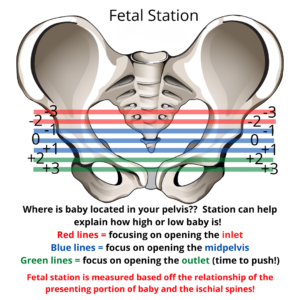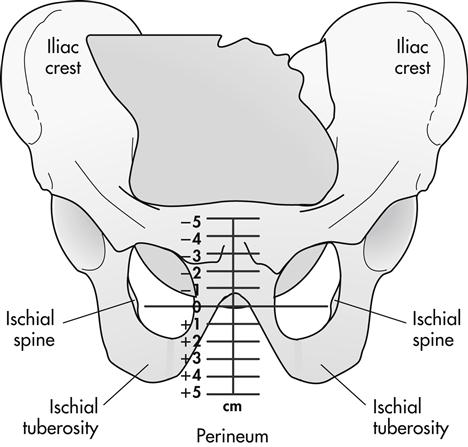Do You Know the Fetal Stations and What They Mean?
Fetal station is something your doctor may check as your delivery date nears or when you are checked when you get to the hospital or birthing center. It is a measurement of how far the baby has descended in the pelvis and is measured by the relationship of the fetal head to the ischial spines (sit bones). The ischial spines are approximately 3 to 4 centimeters inside the vagina and are used as the reference point f or the station score.
Station is the measurement of fetal descent in labor and is measured using a vaginal exam. It generally isn’t measured until the last weeks of pregnancy or when you go into labor.
Why It’s Important
The station number is one of the signs of progression in labor.  When labor begins, some women will have a baby who is fairly high in the pelvis with a station of -2. Others start labor with a baby that is engaged at a 0 station or lower. In the case of fetal station, lower in the pelvis (and closer to the vaginal opening) means a positive number.
When labor begins, some women will have a baby who is fairly high in the pelvis with a station of -2. Others start labor with a baby that is engaged at a 0 station or lower. In the case of fetal station, lower in the pelvis (and closer to the vaginal opening) means a positive number.
Sometime you may hear someone say the baby is coming down which is a positive change in the station of your baby.
How It’s Determined
The measurement of fetal station by a vaginal exam is somewhat subjective and there can be variation between practitioners. The doctor or midwife feels the baby’s head and determines where it is relative to the ischial spines.
The difference between numbers in the score is equivalent to the length in centimeters. Moving from +1 to +2 is a movement of about 1 centimeter.
Fetal Station Numbers
Fetal station is stated in negative and positive numbers.
- -5 station is a floating baby
- -3 station is when the head is above the pelvis
- 0 station is when the head is at the bottom of the pelvis, also know as being fully engaged
- +3 station is within the birth canal
- +5 station is crowning
Fetal Station and Bishop Score
Fetal station is also one of the five components of the Bishop score, which is used to evaluate the cervix’s readiness for labor and to predict whether you will need to have labor induced. The other factors in the score are also determined by the vaginal examination. They include cervical dilation, cervical effacement, cervical consistency and cervical position.
A Bishop score of 10 (out of a possible 13) or more indicates the cervix is ripe and you are likely to have a spontaneous labor and delivery. A score of 8 or more indicates you are a good candidate for induction, while a score of under 6 indicates you are less likely to go into labor and induction is less favorable. A score of 3 or less denotes a cervix that is unfavorable for an induction unless a cervical ripening agent is used.
A commonly used modified Bishop score uses just station, dilation and effacement instead. With this more simplified scoring system, a score of 5 or more (out of 9) indicates cervical ripeness. Preference of the doctor, the specifics of your pregnancy and medical history and other factors will determine which scoring method is used.
Fetal station is just one of the factors that indicate progress is childbirth. It always helps to have more information and understand the terminology of labor but know that every delivery is different and that your baby’s station can shift quickly. If you have any questions or concerns ask your doctor or midwife.
Be sure to review information on this site for more guidance for pregnancy, labor and delivery.





